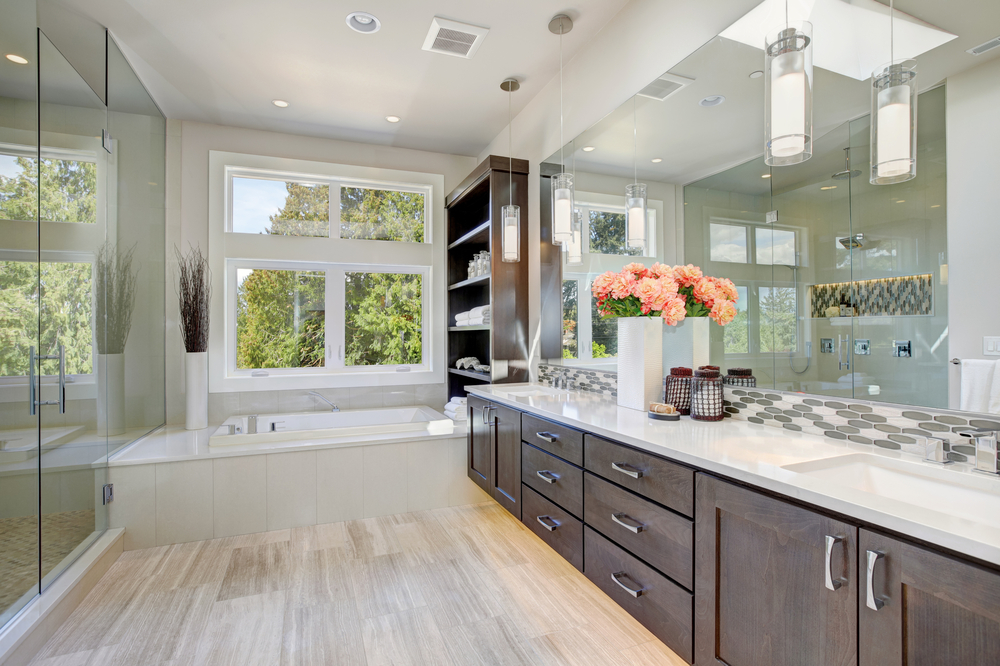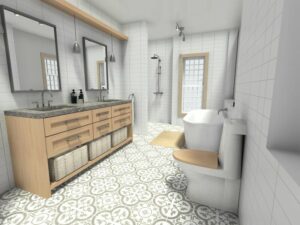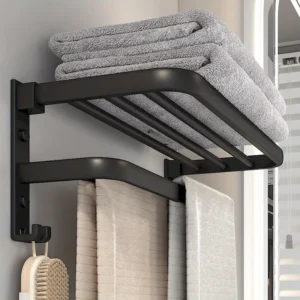Bathroom flooring plays a crucial role in both the aesthetics and functionality of your bathroom. Given the high moisture levels and frequent use, selecting the right flooring material is essential to ensure durability, safety, and ease of maintenance. This comprehensive guide will explore various bathroom flooring options, their pros and cons, and essential factors to consider before making a choice.
Factors to Consider When Choosing Bathroom Flooring
Before diving into specific flooring materials, it’s important to understand the key factors to consider when selecting bathroom flooring:
- Water Resistance: Since bathrooms are prone to spills and high humidity, water-resistant or waterproof flooring is essential.
- Durability: The flooring should withstand frequent foot traffic, cleaning chemicals, and potential drops of heavy objects.
- Slip Resistance: Safety is a priority, so choosing slip-resistant materials can help prevent accidents.
- Ease of Maintenance: Some flooring materials require regular sealing or special cleaning methods, while others are low-maintenance.
- Aesthetic Appeal: Your bathroom flooring should complement the overall design and decor of the space.
- Cost: Budget plays a significant role in decision-making. Some materials offer high-end luxury, while others provide cost-effective solutions.
Popular Bathroom Flooring Options
1. Ceramic and Porcelain Tile
Ceramic and porcelain tiles are among the most popular choices for bathroom flooring due to their water resistance and stylish appearance.
Pros:
- Highly water-resistant
- Wide variety of colors, patterns, and textures
- Easy to clean and maintain
- Durable and long-lasting
Cons:
- Can be cold underfoot unless paired with radiant heating
- Hard surface may be uncomfortable to stand on for long periods
- Grout lines require regular cleaning and sealing to prevent mold buildup
2. Vinyl Flooring
Vinyl flooring has gained popularity in modern bathrooms due to its affordability and waterproof properties. It is available in sheet, tile, or plank form.
Pros:
- 100% waterproof
- Budget-friendly
- Soft and comfortable underfoot
- Easy to install and maintain
- Wide range of styles that mimic wood or stone
Cons:
- Can dent or scratch over time
- Lower-end vinyl may look less premium
3. Natural Stone
For homeowners looking for a luxurious and elegant touch, natural stone is an excellent bathroom flooring option. Materials like marble, granite, slate, and travertine provide a sophisticated appearance.
Pros:
- Timeless and elegant look
- Adds value to your home
- Extremely durable with proper maintenance
- Variety of textures and finishes available
Cons:
- Expensive and high installation costs
- Requires sealing to maintain water resistance
- Can be slippery if polished
4. Engineered Wood
While solid hardwood is not suitable for bathrooms due to moisture concerns, engineered wood is a viable alternative. It features a plywood base with a real wood veneer on top.
Pros:
- Warm and natural appearance
- More water-resistant than solid hardwood
- Available in various wood species and finishes
Cons:
- Not completely waterproof
- Requires careful maintenance to prevent water damage
- Can be costly compared to other options
5. Laminate Flooring
Laminate flooring is a budget-friendly alternative that mimics the appearance of wood or stone. However, it requires special care in wet environments.
Pros:
- Affordable and easy to install
- Available in various styles
- Comfortable underfoot
Cons:
- Not entirely waterproof; water damage can cause warping
- Can be slippery when wet
6. Concrete Flooring
For a modern and minimalist look, concrete flooring is a trendy option. It can be stained, polished, or textured to match different bathroom styles.
Pros:
- Highly durable and long-lasting
- Water-resistant when properly sealed
- Customizable with stains, colors, and finishes
Cons:
- Can feel hard and cold underfoot
- Requires sealing to prevent stains and moisture absorption
Best Bathroom Flooring for Different Needs
| Requirement | Recommended Flooring |
|---|---|
| Budget-friendly | Vinyl, laminate |
| Luxury & elegance | Natural stone, porcelain tile |
| Durability | Ceramic/porcelain tile, natural stone, concrete |
| Easy maintenance | Vinyl, ceramic tile |
| Slip-resistant | Textured stone, matte-finish tile, slip-resistant vinyl |
Bathroom Flooring Installation Tips
- Ensure a Level Subfloor: A smooth and level subfloor is essential to prevent cracks and uneven surfaces.
- Use Waterproof Adhesives and Sealants: Proper sealing enhances durability and prevents moisture damage.
- Consider Professional Installation for Complex Materials: While vinyl and laminate can be DIY-friendly, stone and tile require expert installation.
- Add Area Rugs or Mats: Non-slip bathroom rugs enhance safety and comfort.
Conclusion
Choosing the right bathroom flooring is essential for creating a functional, stylish, and safe space. With options ranging from durable ceramic tiles to budget-friendly vinyl and luxurious natural stone, there is a perfect flooring solution for every bathroom style and budget. By considering factors like water resistance, maintenance needs, and aesthetic preferences, you can select bathroom flooring that not only enhances your space but also stands the test of time. Whether you opt for classic tiles or modern concrete, investing in quality flooring will improve the overall look and functionality of your bathroom for years to come.
You may also read
Victorian house






